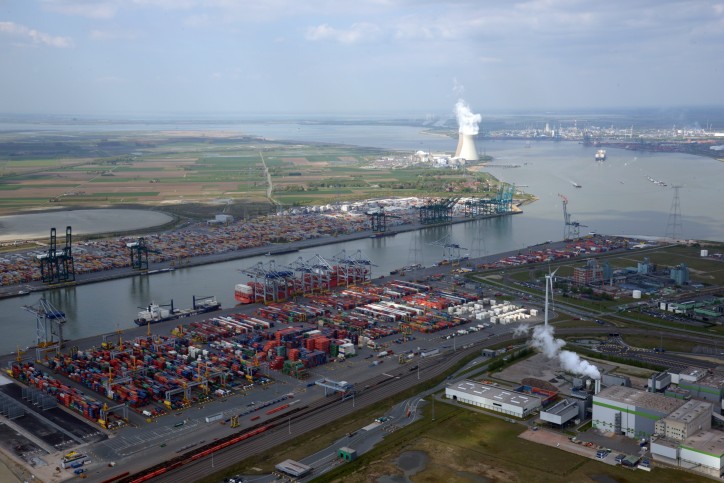The freight volume handled by the port of Antwerp continues to expand. After nine months the total this year stands at 167.1 million tonnes, an increase of 3.3% compared with the same period last year. Strong growth has been recorded in practically all sectors up until the end of September: containers are up by 3.7% in tonnage (to 91.9 million tonnes), liquid bulk such as oil derivatives is up by 2.4% (to 54.4 million tonnes), conventional breakbulk such as steel is up by 7.7% (to 7.8 million tonnes) while ro/ro completes the progression with growth of 10.7% (to 3.7 million tonnes). The only slight decline was noted in dry bulk, such as coal and ore, down by 0.8% after nine months.

“In the last quarter too we are managing to maintain the same high pace of expansion as in the previous nine months,” says Port Authority CEO Jacques Vandermeiren. “In fact this trend is holding steady from past years. Antwerp has been performing extremely well for quite a time now in a market that is otherwise characterised by volatility and fluctuations. If in such a situation you manage to not only maintain but also grow your market share, that gives you confidence in the future."
Containers
The container volume expanded by 3.7% in tonnage during the first nine months (to 91,904,088 tonnes), or 3.2% in TEU. A total of 7,798,016 TEU was handled in Antwerp in the first three quarters. 4.6% more full containers were handled, while the number of empties fell by 4.4%. As regards trading routes, Antwerp made progress in particular in North America (up 9.5%) and the Far East (up 9.3%). The US shows growth of 6.7% in laden containers, and with the number of inbound full boxes up by 8.7% exports from the US are clearly trending upwards. In Europe, however, Antwerp’s largest trading partner, the port lost volume (down 4.5%), which can be attributed to a loss in inbound shipments of transshipment cargo. The growth in containers is due in part to the sailing schedules of the new alliances who by choosing Antwerp as a port of call have confirmed the port’s position in North-West Europe. For the other part, new liner services have been started up which have opted resolutely for Antwerp. The result has been a sharp growth in container freight: over the past nine months the second quarter was the best ever for Antwerp with 2,663,590 TEU, followed closely by the third quarter with 2,654,711 TEU.
Breakbulk
Ro/ro freight is experiencing strong growth this year: so far it is up 10.7% to 3,752,577 tonnes. In particular there have been strong imports of paper carried as ro/ro, up by 250,000 tonnes or 89%. But in fact, both imports and exports of rolling stock have expanded on most trading routes. In the meantime the number of cars handled has risen by 3.4% to 919,793 units. Conventional breakbulk for its part has made strong progress in comparison with the same period last year. At the end of September the volume stood at 7,829,415 tonnes, an increase of 7.7%. In this segment there was particularly strong growth in imports and exports of iron and steel, with coils doing especially well. There was also very strong growth in imports of raw iron and steel from India, (up by 190% or 600,000 tonnes). These figures contrast with a fall in imports from China (down by 38% or 420,000 tonnes). This development is explained by the anti-dumping measures taken by Europe to restrict imports of Chinese steel being sold below market price. Recently the EU has also imposed tariffs on imports of coils from Russia, Brazil, Ukraine and Iran. Steel imports from these countries have fallen sharply as a result. .
Liquid bulk
The volume of liquid bulk was up by 2.4% at the end of nine months, at 54,462,733 tonnes. The rise of 11.4% in exports of liquid fuels stands in contract with the decline of 12.8% in imports during the same period, so that the total volume is practically the same at 30,817,999 tonnes. The overall rise in the total volume of liquid bulk is driven by swelled imports of crude oil, up 28.0% to 4,360,575 tonnes. The volume of chemical products has risen by 2.0% to 10,638,133 tonnes.
Dry bulk
The volume of dry bulk handled during the first three quarters has declined slightly, by 0.8%, to 9,200,951 tonnes. The amount of fertilisers, the largest category of dry bulk, on the other hand has risen by 7.4% to 2,828,534 tonnes; with both exports (up 6.4%) and imports (up 9.5%) doing well. The volume of ore, in particular, has grown by 23.2%, to 1,840,806 tonnes, thanks to imports of iron ore being 2.5 times as large as in the same period last year. At the other end of the spectrum there has been a precipitous decline in the volume of coal handled, down by 55.6% to 396,518 tonnes.
Seagoing ships
The volume of dry bulk handled during the first three quarters has declined slightly, by 0.8%, to 9,200,951 tonnes. The amount of fertilisers, the largest category of dry bulk, on the other hand has risen by 7.4% to 2,828,534 tonnes; with both exports (up 6.4%) and imports (up 9.5%) doing well. The volume of ore, in particular, has grown by 23.2%, to 1,840,806 tonnes, thanks to imports of iron ore being 2.5 times as large as in the same period last year. At the other end of the spectrum there has been a precipitous decline in the volume of coal handled, down by 55.6% to 396,518 tonnes.
Source: Port of Antwerp